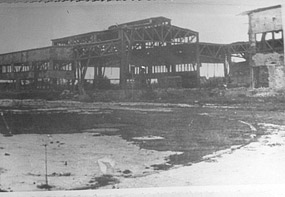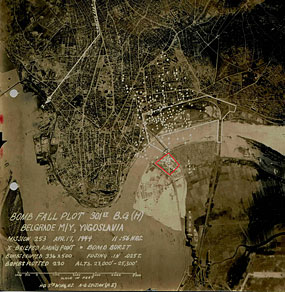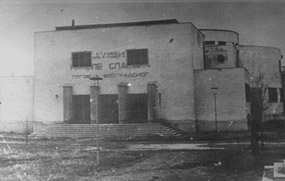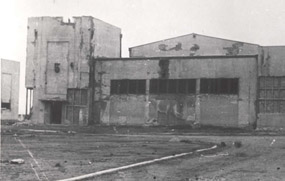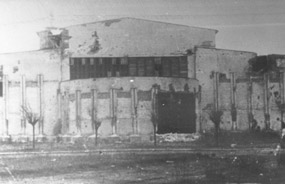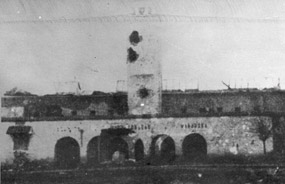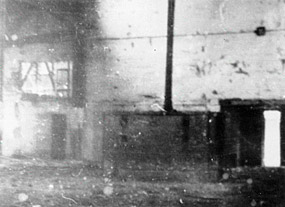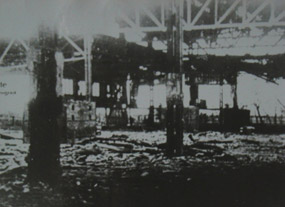English | Srpski
Semlin camp after the allied bombing of April 1944
During the Allied bombing of Belgrade, on 17 April, 1944, the Semlin camp suffered extensive damage. The largest pavilion - No.3 - which housed most of the interns was directly hit and almost completely destroyed. Estimates regarding the number of casualties vary considerably, ranging from eighty to two hundred dead. Many more we wounded in the attack.
The photo below is from a report which was submitted by the crew of US Air Force 301st Bombardment Group after the 17 April mission over Belgrade. (The boundaries of the Semlin camp complex have been marked in red for the purposes of this webpage). The photo suggests that the B-17 Flying Fortresses targeted the nearby bridges and the area directly opposite the camp (the docklands and a railway junction), rather than the camp itself. However, the location of actual 'bomb bursts' (marked with white spots) reveals the imprecision of gravity-guided ordnance used in the bombing campaign. (click photo to enlarge)
In memoirs published in the 1960s, Dr Dragomir Stevanović who worked as a doctor at the camp between 1942 and 1944 offers the following description of that fateful day:
'On the second day of Easter, we found ourselves in what felt like the middle of Mount Etna, or a scorching geyser. Above and below us everything shuddered, flared, and burned, while we suffocated in clouds of dust and smoke. I lived through the [German] bombing of April 1941, but it was never like this. The square [in the middle of the camp] was covered with corpses and torn bodies, and the sand was saturated with fresh and coagulated blood: a real carnage! We lost around 190 people. Besides the dead, there were several hundred wounded, so the surviving pavilions were turned into hospitals. There were no beds, and certainly no bandages or surgical equipment, although we did have several doctors and surgeons among the interns […] During the bombing, the fence was damaged and a number of concrete poles that were holding it in place were dislodged. Several groups of interns tried to escape. However, because of the bareness of the terrain leading towards the River Sava and to Zemun, they were all mowed down by gunfire. Their bodies were brought back to the camp. We never found out how many died.'
Although there is no evidence that the Semlin camp was deliberately targeted by the Allies, a number of survivors believed that the events of 17 April 1944 were not an accident. One survivor, Olga Veličković- Nikolić, remarked in a letter written in October 1944, that the raid was 'more than an atrocity' because the bombers 'aimed directly at the camp'. Dragomir Stevanović, who was interned as a sympathiser of the Chetniks of Draža Mihajlović went as far as to suggest that Tito ordered the camp to be bombed because 'the majority of the interns at the time were anti-communists'. However there is no evidence to support this claim.
The Partisan publication Istina [Truth] welcomed the raid on Belgrade, given that at that time the capital was still regarded by the insurgents as a German 'stronghold'. The report on the bombing of Sajmište published in Istina at the end of April, placed a positive 'spin' on the event,focusing exclusively on the attempted escape by the interns during the raid.
Photos of the site of the Semlin camp taken shortly after the liberation of Belgrade in October 1944
(Photos courtesy of the Jewish Historical Museum, Belgrade)

